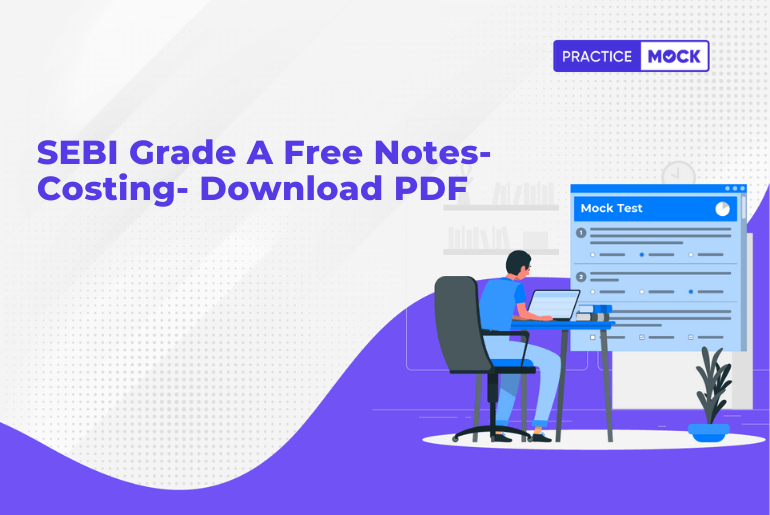In this article, we are helping you with the Free PDF notes of Costing for SEBI Grade A Phase II. We hope that it will help you in your preparation.
- Overview of Cost and Management Accounting – Introduction to Cost and Management Accounting, Objectives and Scope of Cost and Management Accounting (Cost Accounting, Objectives of Cost Accounting, Importance of Cost Accounting, Scope of Cost Accounting, Classification of Costs, Management Accounting, Features of Management Accounting, Uses of Management Accounting, Role of Management Accounting)
- Methods of Costing – Single Output/ Unit Costing, Job Costing, Batch Costing, Contract Costing, Process/Operation Costing, Costing of Service Sectors (Methods of Costing, Job Costing, Features of Job Costing, Methodology used in Job Costing, Advantages of Job Costing, Limitations of Job Costing, Batch costing, Features of Batch Costing, Application of Batch Costing, Contract Costing, Other points in Contract Costing, Multiple Costing, Process Costing, Features of process costing, Advantages of process costing, Limitations of process costing, Preparing Process Cost Account, Inter-process profit, Valuation of Work-in-Progress, Unit or Single or Output or single-output Costing, Operating Costing, Operation Costing, Features of Operation Costing)
- Basics of Cost Control and Analysis – (i) Standard Costing, (ii) Marginal Costing, (iii) Budget and Budgetary Control (Standard Costing, Features of Standard Costing, Application of Standard Costing, Type of Standards, Setting of Standard Costs, Direct Material Standards, Direct Labour Standards, Factor Overheads Standards, Administration Cost Standards, Selling and Distribution Cost Standards, Variance Analysis, Material Variance Analysis, Labour Variance Analysis, Overheads Variance Analysis, Fixed Overhead Variance, Variable Overhead Variance, Accounting Treatment for Variances, Marginal Costing, Features of Marginal Costing, Advantages of Marginal Costing, Limitations of Marginal Costing, Break-Even Analysis/Cost-Volume-Profit Analysis, Objective of Break-Even Analysis/Cost-Volume-Profit Analysis, Assumptions of Break-Even Analysis, Advantages of Break-Even Analysis, Limitations of Break-Even Analysis, Use of Cost-Volume-Profit Analysis, Assumptions of Cost-Volume-Profit Analysis, Methods for Determining Break-Even Points, Contribution, Marginal Cost Equation, Profit-Volume Ratio, Interpretation of Profit-Volume Ratio, Significance of Profit-Volume Ratio, Margin of Safety, Application of Marginal Costing, Profit planning, Evaluation of Performance, Make or Buy Decisions, Closure of a Department or Discontinuance of a Product, Maintaining a Desired Level of Profit, Offering Quotations, Accepting an Offer or Exporting below Normal Price, Alternative Use of Production Facilities, Problem of Key Factor, Selection of a Suitable Product Mix, Composite Break-Even Point, Absorption Costing, Difference between Absorption Costing and Marginal Costing, Budget, Budgeting and Budgetary Control, Budget, Budgeting, Budgetary Control, Forecast and Budget, Objectives of Budgeting, Benefits of Budgeting, Preparation of a Budgetary Control, Types of Budgets, On the basis of Scope, On the basis of Efficiency, On the basis of Conditions, On the basis of Period, Zero Base Budgeting, Applications of Zero Base Budgeting, Benefits from Zero Based Budgeting, Limitations of Zero Based Budgeting, Performance Budgeting, Programme Budgeting)
- Lean System and Innovation:-
- Introduction to Lean System
- Just-in-Time (JIT)
- Kaizen Costing
- 5 Ss
- Total Productive Maintenance (TPM)
- Cellular Manufacturing/ One-Piece Flow Production Systems
- Six Sigma (SS)
- Introduction to Process Innovation and Business Process Re-engineering (BPR) (Lean System and Innovation, Introduction to Lean System, Features of Lean Manufacturing, Just-In-Time (JIT), Features of Just-In-Time, Benefits of Just-In-Time, Pre-requisites of Just-In-Time, Desirable factor of Just-In-Time, Impact of using Just-In-Time in Inventory Control, Just-In-Time as a tool to improve an organization’s profitability, Just-In-Time and overhead costs, Back-flushing in a Just-In-Time System, Kaizen Costing, Kaizen Costing Principle, 5 S, Total Productive Maintenance (TPM, Introduction of TPM in an Organization, Eight Pillars of TPM, Performance Measurement in TPM, Cellular Manufacturing/ One-Piece Flow Production Systems, Implementation Process, Difficulties in creating flow, Benefits of Cell Manufacturing, Limitations of Cell Manufacturing, Six Sigma, Numerical Concept of Six Sigma, Implementation of Six Sigma, Similarities between DMAIC and DMADV, Difference between DMAIC and DMADV, Quality Management Tools, Limitations of Six Sigma, Lean Six Sigma, Process Innovation (PI) and Business Process Re-engineering (BPR), Process Innovation, Business Process Re-engineering (BPR), Principles of Business Process Re-engineering (BPR), Main Stages of Business Process Re-engineering (BPR))
We sincerely hope that the above notes will be helpful in your preparation.
- Sign Up on Practicemock for Updated Current Affairs, Free Topic Tests and Free Mini Mocks
- Sign Up Here to Download Free Study Material
Free Mock Tests for the Upcoming Exams
- RRB PO 2024 Free Mock Test
- RRB Clerk 2024 Free Mock Test
- SSC MTS Free Mock Test
- SSC CHSL Free Mock Test
- SSC CGL Free Mock Test
- GATE Mechanical Free Mock Test
- GATE Civil Free Mock Test
- NABARD Gr. A Free Mock Test
- SBI Clerk Mains Free Mock Test
- SSC CPO Free Mock Test
- AFCAT Free Mock Test
- CAT Free Mock Test
- NIACL Assistant Free Mock Test
- UIIC AO Free Mock Test
- UIIC Assistant Free Mock Test
- GIC Assistant Manager Free Mock Test
- NICL AO Free Mock Test
- Free SSC Live Test
- UPSC CSAT Free Mock Test
- CDS-I Free Mock Test
- RRB ALP Free Mock Test


